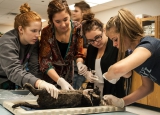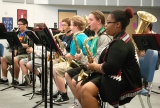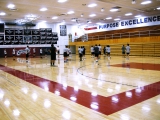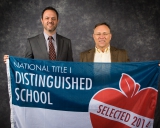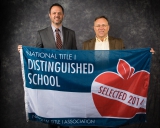-
Category 1
Selected in 2014
-
Grades: 9 - 12
School Setting: suburban
Town Population: 170,000
Student Enrollment: 1,800
Student Demographics:
Black/African American: 9%
Teacher/Student Ratio: 1:27.5
White/Caucasian: 35%
Hispanic: 42%
Hawaiian/Pacific Islander: 1%
Asian: 4%
Native American: 6%
Other: 3%
% Reduced Lunch: 42%
% ELL Learners: 1%
Founded: 1964 -
PRINCIPAL:
Derek Hoffland -
CONTACT:
1830 East Del Rio Drive
Tempe, AZ 85282
480-752-8625
dhoffland@tempeunion.org
McClintock High School
Tempe, AZ
McClintock High School has for 50 years had a strong culture of excellence, but in the most recent decade as demographics have changed and the poverty rate has risen, more students come to our school without the necessary motivation to excel and often without the necessary prerequisite skills to succeed without supplementary reading or math programs. To counteract this we have diligently worked to educate our students about the purpose of an education and to instill in all students the sense of their own responsibility toward excellence.
- Describe specific programs in place to ensure that families are involved in the success of your school and students.
-
Reaching out and involving Title 1 families has always been a challenge and is especially so at the high school level. However, we have addressed these challenges and are continually evolving to meet the needs of our families. Besides keeping parents updated on their child’s attendance, the parent liaison was tasked with disseminating information on school programs, the parent portal, and upcoming NPLB University parent/teen workshops. Another means of engaging the families was to invite them to attend the Annual Spring Award’s Night where the families congregated to hear accolades and see their child receive a certificate of achievement. Lastly, parents were represented and contributed in the Title 1 Program Design process.
Presently, the paradigm of family involvement is still evolving as we are moving away from random acts of family involvement to engaging families in a school/family partnership and meaningful two-way communications in order to increase student achievement.
- Describe the most successful activity your school has initiated to strengthen ties to your community.
-
By participating in the Annual Spring Award’s Night, McClintock’s Title 1 students have the chance to be recognized and celebrated by their teachers and families. Each spring, Title families are personally invited to the school to witness and celebrate their child’s achievements. Upon arrival, parents are greeted, presented with a program, and escorted into a decorated auditorium. The program begins with a slide show that features each student and is followed by the teachers providing accolades and presenting their students with a certificate of achievement. At the conclusion of the ceremony, refreshments are available and the families have a chance to mingle.
This event may seem like an ordinary end-of-the-year celebration, but in the eyes of our Title 1 community, McClintock has leveled the playing field between our Title students and their higher achieving counterparts as we acknowledge students who may not have been recognized or celebrated since their elementary years.
- Describe your philosophy of school change or improvement.
- Like many other schools, at McClintock High School we believe the status quo is not good enough for our community. We have high expectations of our administration, our teachers, all other staff, our students, and their support systems. As we progress and begin to approach our goals we set them higher. Although we are a highly achieving school, we continue to research and collaborate with the goal of being better tomorrow than we are today. We consider all manner of data in doing this, and our staff is comfortable moving forward with new strategies and programs for the improvement of our school. We do work, however, to ensure that what we do we do systematically and do not overload any group of staff.
- What are your school’s top two goals for the next year?
- McClintock High School’s primary goals have to do with the credits students earn. We currently have set the goals that “92% of all courses taken by all freshmen and all sophomores will be passed and that the lower quartile subgroups in both of these cohorts will also pass their classes at the rate of 92%.” Our classroom teachers have very high expectations and if a student passes their class then that means that the student has learned, grown and achieved highly. It also means, since our curriculum is aligned to state standards, that they will perform highly on the state assessments without consciously focusing on the assessments.
- What is the single most important factor in the success of your school that others could replicate?
- McClintock High School provides a trusting environment. We work diligently to ensure this on a variety of levels: administration – teachers, teachers – students, students – students, teachers – parents, and so on. This trust is built on a foundation of caring, competency, and hard work. Trust is so apparent in our culture and climate that it impacts all that we work toward accomplishing.
- Describe the program or initiative that has had the greatest positive effect on student achievement, including closing achievement or opportunity gaps, if applicable.
- No one program has achieved this at McClintock High School, but instead we would attribute our success to the quality of instruction by the faculty, the willingness of the staff to integrate research-based strategies, and the high expectations set for our students which most work diligently to meet. McClintock teachers have worked in PLCs to develop best-practice lesson plans, they have integrated close reading activities into lessons across the curriculum, they are using learning targets and formative assessment, and they are using a research-based protocol to raise the level of student engagement. These are a few of the school-wide initiatives that are making a difference in the achievement of all students at McClintock.
- Explain how Title I funds are used to support your improvement efforts.
- McClintock High School Title I funds are used for supplementary reading and math programs. In the area of reading, we use funding to provide a support course called Reading Strategies. In this course Title students are provided support to increase skills, primarily using Scholastic’s Read 180 software. Student improvements are monitored via the SRI assessment. Additionally, to support reading, we utilize an instructor as reading interventionist in the science and social studies areas as we have raised the bar with our Title students in these content areas but provide the reading support for their success. In math, we offer a Math Lab course to support students’ success in the content area, providing them the opportunity to master basic skills so that they can achieve in the high school level courses. Each of these courses are filled with students eligible for Title services. As students reach the proficiency level they are exited from the program so that others may enter.
- Identify the critical professional development activities you use to improve teaching and student learning.
- At McClintock High School our most recent PD has focused on lesson planning, formative assessment and critical reading and writing across the content areas. We are currently focusing on student engagement techniques and the implementation of learning targets. All staff development is identified using student achievement data and monitored by measuring progress in the same data sets. When implementing new strategies at McClintock we find it helpful to not only provide quality ongoing PD with our staff, but also to inform the students about the new strategies being implemented.
- Describe how data is used to improve student achievement and inform decision making.
- At McClintock High School we use data to evaluate programs and instruction and to assess student performance. Most generally speaking, we analyze credit data and use it to determine whether grading practices are helping or hindering student motivation. Additionally, teachers analyze, on a yearly basis, strand and concept information from the state’s standardized exams with the goal of making curricular and instructional adjustments. Lastly, but most importantly, our teachers develop and administer common formative assessments and in their PLCs have instructional conversations pertaining to the data with the goal of improving instruction across the board.
- Describe your school culture and explain changes you’ve taken to improve it.
- McClintock High School has for 50 years had a strong culture of excellence, but in the most recent decade as demographics have changed and the poverty rate has risen, more students come to our school without the necessary motivation to excel and often without the necessary prerequisite skills to succeed without supplementary reading or math programs. To counteract this we have diligently worked to educate our students about the purpose of an education and to instill in all students the sense of their own responsibility toward excellence.
Stats
-
Category 1
Selected in 2014
-
Grades: 9 - 12
School Setting: suburban
Town Population: 170,000
Student Enrollment: 1,800
Student Demographics:
Black/African American: 9%
Teacher/Student Ratio: 1:27.5
White/Caucasian: 35%
Hispanic: 42%
Hawaiian/Pacific Islander: 1%
Asian: 4%
Native American: 6%
Other: 3%
% Reduced Lunch: 42%
% ELL Learners: 1%
Founded: 1964 -
PRINCIPAL:
Derek Hoffland -
CONTACT:
1830 East Del Rio Drive
Tempe, AZ 85282
480-752-8625
dhoffland@tempeunion.org




